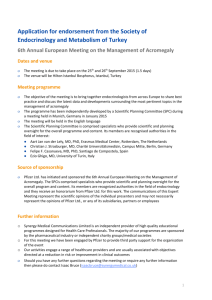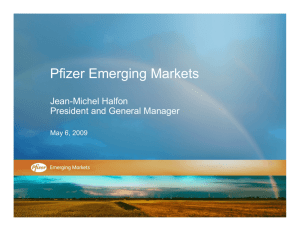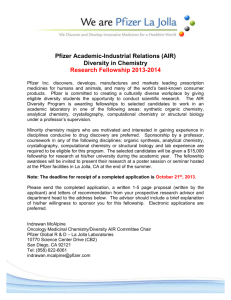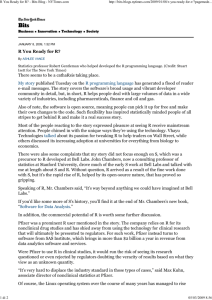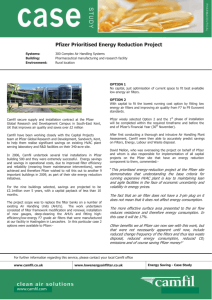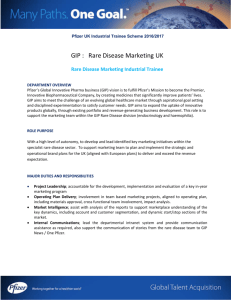File - Phillip Warren's Portfolio
advertisement
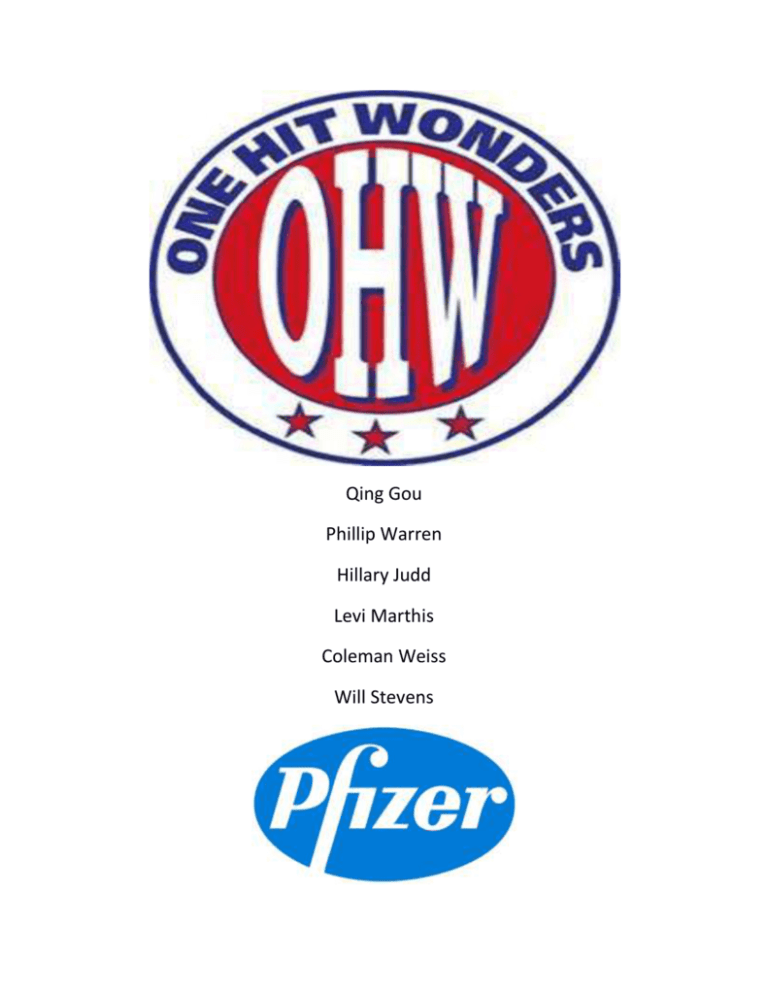
Qing Gou Phillip Warren Hillary Judd Levi Marthis Coleman Weiss Will Stevens Table of Contents Introduction ........................................................................................................... 2 Company History and Description.......................................................................... 2 Industry Description............................................................................................... 3 SWOT Analysis ....................................................................................................... 4 Strengths ............................................................................................................ 4 Weaknesses ........................................................................................................ 5 Opportunities ..................................................................................................... 5 Threats................................................................................................................ 6 IFE, EFE, and TOWS ................................................................................................ 6 Preferred Strategy ................................................................................................. 8 Cost Benefit Analysis .............................................................................................. 9 Conclusion ............................................................................................................. 9 References ........................................................................................................... 10 Appendices .......................................................................................................... 11 Introduction Global pharmaceuticals grew by 3.6% in 2010 to reach over $733 billion with projections reaching $981 billion by the year 2015 (Pharmaceuticals Industry Profile: Global, 2011). Pfizer, the world leader in the global pharmaceuticals market, controls an impressive 9.4% of the global market share (Pharmaceuticals Industry Profile: Global, 2011). Sometimes described as Frankenstein’s Monster, Pfizer has been aggressively swallowing up smaller companies since the early 1990’s to become the present day drug giant. Pfizer along with other companies will be facing a fork in the road in the near future as they exit their blockbuster growth with the expiration of many of the company’s most successful drug patents. In this paper we will conduct several analyses to identify strategies that would be viable options for the company. Pfizer, which has been a company that has dominated with its inorganic growth in the past (Appendix N), will now have to decide what road to choose to maintain their competitive advantage and continue to be the global leader. Company History and Description Started in 1849 with a $2,500 dollar loan from Charles Pfizer’s father, a fine chemicals business was started by the name of Charles Pfizer and Company (Pfizer, 2012). Charles Pfizer, a chemist, and his cousin Charles Erhart, a confectioner, both young entrepreneurs from Germany, were the 2 founders of the business (Pfizer, 2012). When the business launched their office, laboratory, factory, and warehouse were all operating in the same building. The two cousins combined their skills to begin to manufacture chemicals, the first being a form of santonin that was used to treat intestinal worms which was widespread problem at the time (Pfizer, 2012). Though Pfizer has been a successful company since the beginning, the Civil War could be seen as the explosion point for the company that put them on the track to where they are now. Through the years the company has entered and exited several different chemical markets yet always stayed true to doing things the way that Charles Pfizer intended, dedication to the customers while maintaining the highest quality and efficiency possible. Since then Pfizer has become the world’s largest research based pharmaceutical company (Pfizer, 2012). The company’s focus is on development and manufacturing of health care products. They also have an animal health product line. Pfizer is now operating in over 150 countries. In the recent 2000’s Pfizer had acquisitions with Wyeth and King Pharmaceuticals. Pfizer’s primary NAICS code is for Pharmaceutical and Medicine manufacturing (32541). Industry Description Using Porter’s Five Forces to analyze the pharmaceutical industry we have concluded the following information. Most prescriptions are required to acquire pharmaceutical products and in most cases a public or private sector health insurer is the major source of purchase funds. This increased buyer power, where as the high importance of pharmaceuticals in healthcare weakens buyer power which overall makes it moderate. The supplier power is also at a moderate level because of such irregular attributes involved with the industry. Over recent years, larger companies have turned to producing their own chemicals in a bid to enhance profits, however smaller companies lack the resources required to do this and remain reliant on active ingredient manufacturers. Barriers to entry for generic companies depend on expiry of patents and if the patent holder protects it therefore making it weak for new entrants. Generics and biosimilars are beneficial alternatives and few costs are involved in changing over to them creating strong threats for substitutes. It is easy to exit this industry and assets can be sold relatively easy creating a moderate degree of rivalry (Pharmaceuticals Industry Profile Global, pages 13 – 24). Pfizer is the world’s largest biopharmaceutical company. Its portfolio includes human and animal biologic, small molecule medicines, vaccines, nutritional and consumer products. The company operates in more than 150 countries. It is headquartered in New York City, New York and employed 110,600 people as of December 31, 2009. Pfizer completed the acquisition of King Pharmaceuticals, a US-based specialty pharmaceutical company, for $3.6 billion in February 2011. The company recorded revenues of $67,809 million during the financial year (FY) ended December 2010, an increase of 35.6% over FY2009. The operating profit of the company was $9,422 million during FY2010, a decrease of 13% over FY2009. The net profit was $8,257 million in FY2010, a decrease of 4.4% over FY2009. SWOT Analysis Tows Strategies: SWOT factors are from the IFE, EFE Type S-O S-O S-O S-T W-T W-O Strategy Acquire companies with access to emerging markets acquire assets in the biologics market Marketing campaign in emerging markets Buy the competition Divestiture of underperforming or unaligned assets Expand into Biologics market Factors O1, S1, S3, S4 O4, S1, S4 O1, S2, S5 S4, T4 W2, T2 O4, W3 Weight 2.97 2.76 1.89 1.38 0.95 0.90 Strengths For the last decade Pfizer has moved to acquire and merge with numerous companies and in the last three years have maintained growth despite and operational decline. Revenues increased drm by 1% in 2011 despite an operational decline of 4% or $2.9 billion. This increase in revenue is attributed mainly to the acquisition of King Pharmaceuticals in early of 2011 which helped to offset the operational decline by $1.3 billion. (Pfizer Financial Report: 2011, 2011) In 2009, Pfizer acquired Wyeth, along with Wyeth’s top selling drug, Lipitor. Lipitor represented 1/5 of Pfizer’s total revenues in 2011. These acquisitions of competing pharmaceutical companies and their intellectual properties has facilitated Pfizer’s continual growth through the last decade and possibly into the future. Weaknesses Unfortunately one of Pfizer’s strengths is the byproduct of its greatest weakness. Pfizer has followed a trend of acquiring competition with successful products and promising research and development programs. There is a growing trend within the pharmaceutical industry to reduce funding to its research and development divisions because of the low percentage of successful products being produced. Currently there are fewer drugs being developed relative to the amount losing the patents. Pfizer has instead focused on acquiring other companies for their drugs and research. This has made Pfizer completely dependent upon their ability to finance these costly acquisitions. Opportunities Emerging markets represents the large opportunity for the pharmaceutical market. According to the IMF emerging markets will account for 80% of the world’s population and two-fifths of the global GDP by 2015. Emerging markets include China, Russia, Brazil, and India. These countries are expected to experience a 14%-17% annual growth of demand in the next three years and will drive a 90% sector growth through 2020. (Standard & Poor’s, 2012.) Of these emerging markets China possesses the largest market of these countries with the world’s largest population and the world’s second largest economy. This economic growth is represented by rising standards of living and a rapid increase in the country’s middle class. China’s government is in the process of reforming its health care legislation implementing a healthcare stimulus package that should expand coverage to over 90% of the country’s population. China represents a very lucrative prospect for pharmaceutical companies in the future with a rapid increase in market demand and healthcare spending. Threats Patent expirations represent a large threat because of the loss of sales too generic drug companies. 11 of the top 20 selling drugs are scheduled to lose their patents between 2012 and 2015. Lipitor, a cholesterol control drug produced by Pfizer, lost its patent in January of this year and as of the end of the quarter pfizer has experienced a decrease in Lipitor sales by 42%. ( Matthew Baldwin LLP, 2012) Industry wide, sales are estimated to decrease by $120 billion from 2011-2015 due to patent expirations. ( Standard & Poor’s, 2011) IFE, EFE, and TOWS After conducting IFE and EFE (Appendix J), we have identified several strategies that we saw as viable options for Pfizer to maintain and advance its competitive advantage. The top three that we will be considering are 1) Acquire companies with access to emerging markets 2) Acquire assets in the biologics market 3) Marketing campaign in emerging markets. The first which carries the largest weight is to acquire companies in emerging markets. Pfizer has been known very well for the company’s inorganic growth by purchasing other companies. This growth strategy has proven to be very beneficial to Pfizer since it started and we believe that it will continue to do so for the company. Many of the Pfizer’s best selling products have been acquired by a company buyout, including Lipitor, the best selling drug in history. Abiding by this strategy, the right company with products that possess a large growth potential must be selected. This is an ideal candidate for Pfizer to maintain its success and growth because of the amount of capital that Pfizer has easy access to. The second strategy to acquire assets in the biologics markets, which shows an unprecedented amount of growth now and in the future. With the top 12 biologic products producing $30 billion in revenues, this market is taking off. Pfizer stands to make up a large amount of the revenue that it is losing with its patent expirations by obtaining assets in the biologics market. The biologics market is an important source of new growth for the pharmaceutical industry, with current size of $40bn and projected growth of 9.3% over the next 4 years (Franco, 2010). On average a single biologic takes 10-15 years to develop and costs $1.2bn (Viana, 2010). Acquiring companies in the biologics sector represents an S-O strategy with a combined TOWS weight of 1.89. Companies such as Halozyme, with a strong product pipeline and with a market cap of less just under $1bn, represent a fast way for a large company such as Pfizer to expand into the growing biologics sector. Pfizer, with earnings of over 10bn/year and a strong balance sheet, could easily afford to acquire one or several companies of this size. Benefits for Pfizer would be acquiring a late-stage biologics product for approximately the price of developing one internally, but without having to wait the full 10-15 years. Costs would be the $1bn price of acquisition plus ongoing negative earnings for this company. Risks include the risk of product failure. The last strategy is to launch marketing campaigns in emerging markets. To remain competitive, pharmaceutical companies are always looking to gain access to the next big market. After identifying an emerging market, people must be made aware of the products that the company manufactures and must be persuaded to use them. Again the large capital structure that Pfizer contains allows for the company to gain these markets. It is all about getting there first, and Pfizer has the resources to be able to identify these markets and to take the advantage before any other companies. Preferred Strategy Following the trend that Pfizer has taken on, our preferred strategy is that of acquiring companies with access to emerging markets. The emerging market that we have chosen to focus on is China, in particular diabetes in China. Currently, over 60% of diabetes cases worldwide are occurring in Asia. In 2010, China had more than 92 million people diagnosed with diabetes and 150 million people were showing early symptoms. Takeda, a company based out of Japan with a large portion of its assets in China is a top tier producer of diabetes medication. Acquiring a company such as this would greatly assist Pfizer in the expansion of its markets and allow them to fill a niche for medication in the diabetes epidemic that is looming over China. Cost Benefit Analysis If Pfizer acquires or enters into a merger with Takeda, both of the companies have the opportunity to acquire a new market. By entering the Chinese market, Pfizer stands to gain a large number of customers from a rapidly expanding population. Pfizer has the opportunity to use the current Chinese health care reform to develop second and third levels in cities and rural markets, and to obtain a new profit source to replace the sales that have been lost due to patent expirations. From Takeda’s Income Statements, we know that their net sales have been steadily decreasing over the past three years since 2009. From Pfizers standpoint, the acquisition of Wyeth in 2010 has boosted their sales in the recent years. With Takeda’s market cap just above $36 billion they are a substantially smaller company than Pfizer, hovering right around $178 billion ("Pfizer inc. competitors," 2011). Financing would most likely be long term debt as Pfizer is currently attempting to buy back many of its shares of stock instead of issuing new shares. Although the upfront cost would be substantial, the acquisition or merger with Takeda would ultimately be very beneficial for Pfizer’s earnings by tapping into the ever expanding Chinese market. With diseases such as diabetes increasing at alarming rates, Pfizer could have their next blockbuster market. Conclusion After researching the pharmaceutical industry’s threats and opportunities, then analyzing Pfizer’s strengths and weaknesses we have proposed three strategies market penetration, related diversification, and market development. Using a TOWS matrix to choose the best strategy to implement for Pfizer would be market penetration. Acquisition of Takeda by Pfizer would impact both companies by switching and combining markets to improve sales. References Pfizer inc. competitors. (2011). Retrieved from http://finance.yahoo.com/q/co?s=PFE Competitors Pharmaceuticals Industry Profile: Global. (2011). Pharmaceuticals Industry Profile: Global, 1-42. Pfizer. (2012). Pfizer- who we are, what we stand for . Retrieved from http://www.pfizer.com/about/history/history.jsp Franco, V. (2010). “Biologics Industry Expected to Grow 9.3% Between 2009 and 2016.” MarketResearch.com. Retrieved July 2012 from http://www.marketwire.com/pressrelease/biologics-industry-expected-to-grow-93-between-2009-and-2016-1321589.htm Viana, L. P. (2010). “The Economics of Biologics.” Upstart Business Journal. Retrieved July 2012 from http://upstart.bizjournals.com/industry-news/health-care/2010/02/05/bigpharma-and-generic-drug-lobby-fights-over-biologics.html?page=all DATAMONITOR: Pfizer Inc. (2011). Pfizer, Inc. - SWOT Analysis, 1-9. "History." A pioneering spirit on the frontier of medicine. Pfizer Inc., 2012. Web. 23 Jul 2012. http://www.pfizer.com/about/history/timeline.jsp Appendices Appendix A Pfizer Balance Sheet Appendix B Pfizer Cash Flow Appendix C Pfizer Dupont Analysis 2011 Appendix D Pfizer Income Statement Appendix E Pfizer Top Grossing Products Appendix F Takeda Additional Cash Flow Appendix G Takeda Balance Sheet Appendix H Takeda Cash Flow Appendix I Takeda Income Statement Appendix K Halo Balance Sheet Appendix L Halo Cash Flow Appendix M Halo Income Statement Appendix N 2000, Pfizer used 90 billion dollars purchase Warnet-Lambert, then became to the largest pharmaceutical organization in all over the world. Form this purchase, Pfizer acquires the patent of “Liptor” which is the No.1 best selling drug in the world. 2002, Pfizer used 60 billion dollars purchase Pharmacia & Upjohn companies that this company is locating in France. From this business, Pfizer acquires 100% ownership of the famous arthritis drug “Celebrex”. 2003, Pfizer used 1.3 billion purchased Esperion which help Pfizer increased their treatment of cholesterol drugs from two to three. 2005, Pfizer used 1.9 billion cash purchased Vicuron company that increased their competitive advantage in anti-infection drugs. 2006, Pfizer purchased a private company in UK, this company’s named PowderMed Ltd, it is a professional company who focus on research and develop new DNA vaccine. 2007, Pfizer used 1640 million dollars purchased Coley, tried to strengthen its vaccine research ability and improve alzheimer’s disease and infection of drugs’ development ability. 2008 Pfizer used 1950 million dollars purchased Encysive biotechnology company. 2008 Pfizer used 7250 million dollars purchased Dimebon’s ownership. 2009 Pfizer used 68 billion to purchased Wyeth company. Appendix O Ratios for Pfizer: Current ratio:2.13 (2010) 2.06(2011) Acid test:.1.445 (2010) =1.438 (2011) Inventory turnover: 8.103 (2010) 8.679 (2011) Days sales outstanding: 72.829 (2010) 73.666 (2011) Fixed assets turnover ratio: 359.7% (2010) 398.1% (2011) Total assets turnover ratio: 34.4% (2010) 35.9% (2011) Debt ratio: 54.7% (2010) 56.1$ (2011) Net profit margin: $0.123 (2010) $0.148 (2011) Market value per share: $17.51 (2010) $ 21.64 (2011) Return on Assets (ROA): 4.23% (2010) 5.32% (2011) Return on Pfizer Inc. shareholders’ equity (ROE): 10.39% (2010) 11.78% (2011) Cash dividends paid per common share: 0.72 (2010) 0.8 (2011) Shareholders’ equity per common share: $10.96 (2010) $10.85 (2011)
